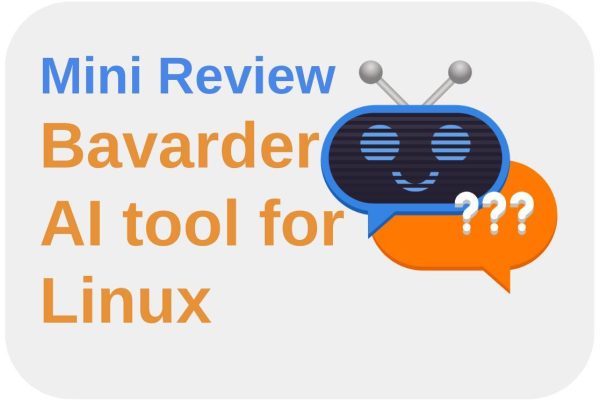Anyone with a bit of an interest in modern technology probably has realized in the last few months that Artificial Intelligence has suddenly become one of the most discussed topics. Whether in the newspaper, in YouTube videos, blog posts, conversations on the train, at the office, or at parties, Artificial Intelligence, in short AI, is the talk of the day everywhere. Many different opinions highlight the different sides of AI, such as the advantages, disadvantages, dangers, and opportunities. Many different solutions have become available in a short time that has brought AI close to the ordinary end user for a variety of applications. AI applications have also become available for Linux. In this article, you can read my mini review on Bavarder, which is a very simple ChatGPT-based AI App for Linux.
Content of this article
- Some background on AI
- What is AI
- Potential dangers of using AI for content creation
- Best practices when using AI for content creation
- What is Bavarder
- How to use Bavarder
Some background on AI
Only a short while ago I already wrote an article on AI on my other website realappuser.com. In the article “How AI can help you be more productive“, I discussed multiple options to use AI-based solutions in our productive life.
I started that article with an explanation of what AI is, and I also tried to cover some potential dangers of using AI and some best practices when using AI. You can read this article for all details, so I won’t go into too much depth here, but below is a short summary.
What is AI
In my aforementioned article, I consider Artificial Intelligence as a form of technology that makes it possible with computer and software support to suggest that the feedback from a computer, based on interaction requested by a human, shows some or a greater degree of intelligence.
Based on a definition of “Intelligence” we can find on Wikipedia…
“Intelligence can be described as the ability to perceive or infer information, and to retain it as knowledge to be applied towards adaptive behaviors within an environment or context.”
Source: https://en.wikipedia.org/wiki/Intelligence
… we can conclude that something is considered intelligent if it can take in information and apply it to perform behaviors needed to adapt to the environment. So, when we extend that to artificial intelligence, it is expected to show the same characteristics: the ability to gather data and learn from it to respond to its environment.
Potential dangers of using AI for content creation
In the same article, I warn, among other things, that AI models and their possibilities are still in their infancy and, based on the data available for these models, can produce incorrect results for the user, while the user can wrongly assume that all results are truthful. In addition, AI-powered web browsers and search engines can compile articles without crediting the original authors, which can affect their revenue, as well as lead to plagiarism. As a writer myself, I realize all too well that my own articles can also feed AI models and that I too do not receive the appreciation my work deserves. In my article I therefore propose to only use AI results as a basis for further research and for new ideas for compiling your own texts, with the primary respect for the intellectual property of others, the assessment of results for correctness, and the providing disclaimers if necessary.
Best practices when using AI for content creation
Also in my article, I provide some best practices when using AI. You can think of practices such as knowing the purpose, value, and context of the content, respecting the intellectual property of the sources used by the AI, visiting the original sources for more information and support, using the AI results as a basis for further research, reviewing and verifying the accuracy and truthfulness of the AI results and providing a disclaimer that AI was used if posting or publishing the content.
What is Bavarder
Now that you have a little more information about what AI is, the dangers to be aware of, and some best practices for using AI properly, it’s finally time to look at the application Bavarder. That was the primary reason why you wanted to read this Mini Review in the first place.
Bavarder (this is a French word, related to small talk) is a very young application developed specifically for Linux and aims to provide a really simple interface.
Bavarder has out-of-the-box 4 AI models activated, namely BAI Chat, Cat GPT, Hugging Chat, and OpenAI GPT 3.5 turbo, but a lot more models can be activated via the Preferences option. Keep in mind that some models need an API key to be able to actually use it via Bavardeen. There is a rapid increase in different AI platforms, such as the aforementioned models. They all have their own specific properties that are beyond the scope of this article for me to explore and discuss in detail here. But on the models being used in Bavarder, more information can be found via the following links:
Bavarder is different from other AI solutions, such as built-in in Microsoft Edge, in which you can choose from multiple conversation styles, tone of voice, output formats, and length of the result via a chat dialog or a compose dialog. Bavarder only offers a dialog box with a Message and a Response area and an option to choose one of the previously mentioned models. But if you become a little handier with these kinds of AI solutions and the way you can start a conversation, the lack of these extra functionalities does not have to be a limitation, since your conversation styles, tone of voice, output formats, and length or the result can be part of your request in your message. More on that in the next section where we’ll be asking some simple questions through Bavarder.
How to use Bavarder
When we start Bavarder we see the following screen (based on version 0.2.0).
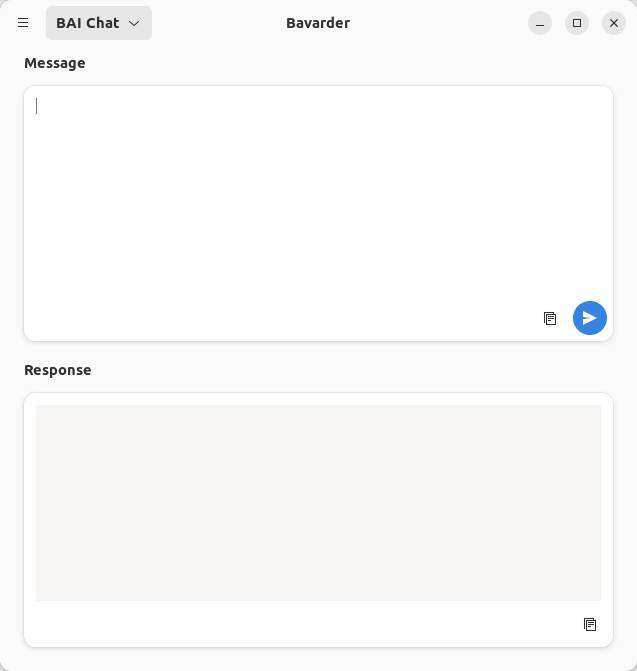
Here we see a number of important components, namely the AI Model selector, the Message area, the Reposonse area, and the main menu.
First, let’s take a look at what the AI Model selector has to offer.
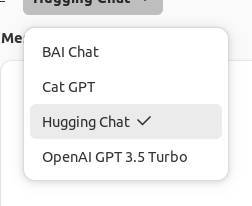
As mentioned before, Bavarder has out-of-the-box 4 AI models activated, namely BAI Chat, Cat GPT, Hugging Chat, and OpenAI GPT 3.5 turbo, but a lot more models can be activated via the Preferences option. Now let’s go to the main menu of Bavarder. There we see the option Now let’s go to the main menu of Bavarder. There we see the Preferences option. When we open Preferences we see the following:
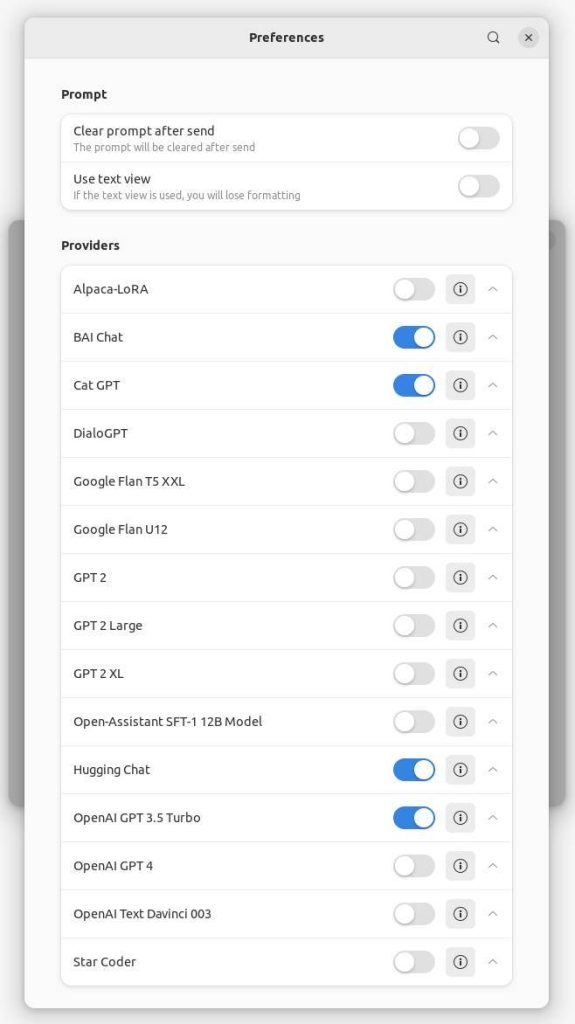
In the Prompt section, we see the option Clear prompt after send and Use text view, which are both deactivated. Use it to your liking. I keep the default settings.
In the Providers section, you see all available ai models which can be activated or deactivated. We keep the default for this article. It is beyond the scope of this article to explain all models and clarify the differences. What is important to know is that for some AI models, you need to have an API key available to be able to actually use it via Bavarder. The API keys can be added in this same dialogue.
Now let’s go back to the main screen and try to ask some questions via Bavarder.
If you are not yet familiar with the way in which you can interact with an AI model, it is good to know that there is a difference in how you ask for information via an AI tool and get results compared to, for example, a classic search engine such as DuckDuckGo. For example, in a classic search engine you ask the question “What are the most popular open-source applications for Linux?” and as a result, you get several pages with links to different web pages that may be able to answer your question. It is up to you to open one or more websites to determine whether it answers your question.
You can ask the same question via an AI tool, but you do not get a list of web pages as a result, but an answer compiled on the basis of various sources. In theory, you no longer have to open the various websites to collect the information, but there is a possible immediately usable answer ready for you.
So let’s try the same question in Bavarder.
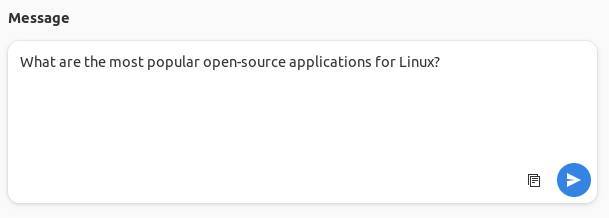
After 5 seconds or so, I get the following Response:
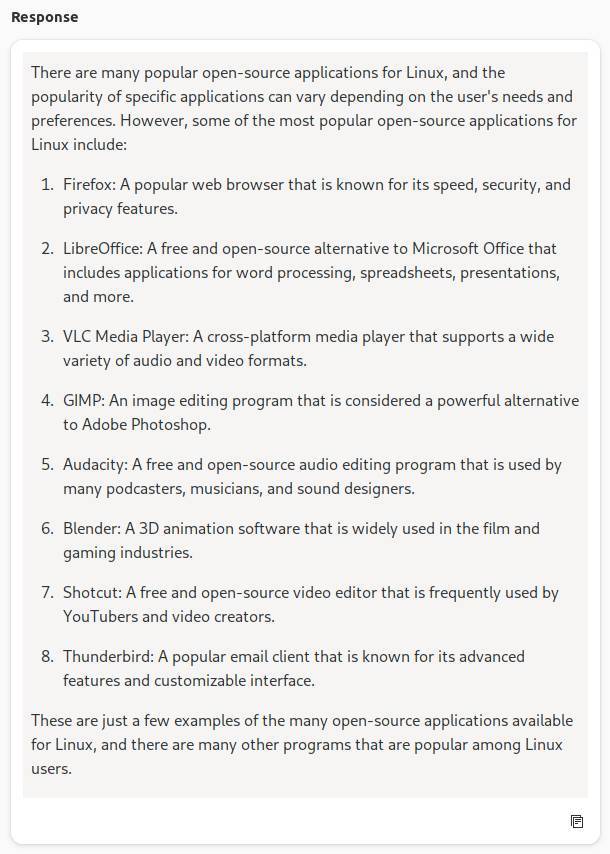
What you see here is a response based on different sources on the internet. The underlying AI model is able to analyze and combine multiple sources and come up with a response that is in this case quite accurate.
It also immediately becomes clear why I pointed out a number of dangers, such as the fact that you no longer have to go to the underlying websites, with the associated consequences for, among other things, the revenue models of the owners of the websites. But that’s a discussion for another time.
But as I mentioned earlier, the result is largely based on the way you asked your question. You can make your question much more specific so that it better matches what you actually need. Let’s make the question more specific.
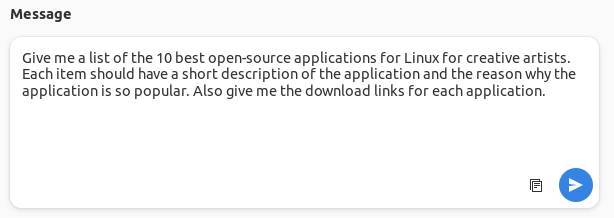
Bavarder, or rather the underlying model, needs much more time for this question. This is not surprising, given the greater degree of detail of the question asked. But after a while, it comes up with a rather nice answer. Here is a part of the complete result.
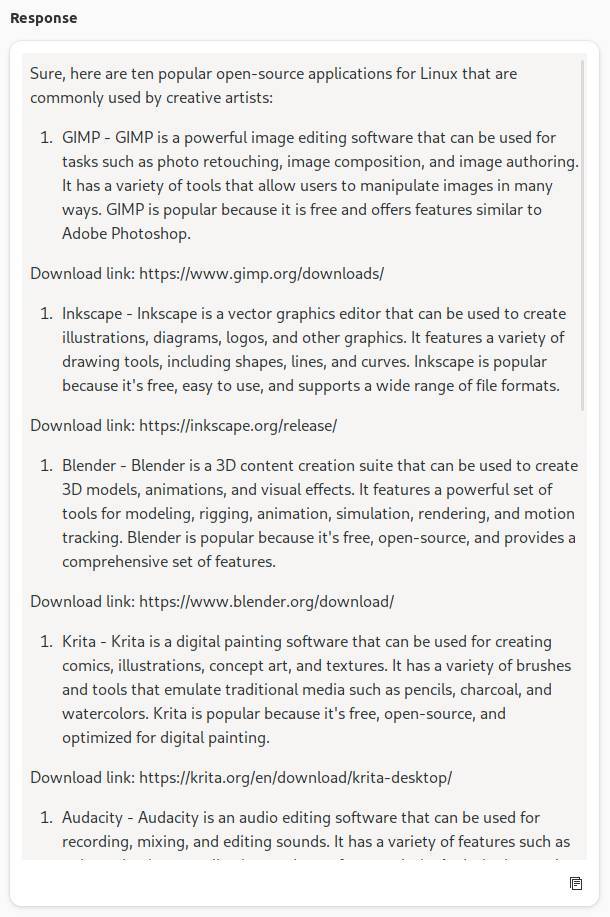
Let’s further extend this question by including the tone of voice (casual) and the type of response (blog post).

Here is the response.
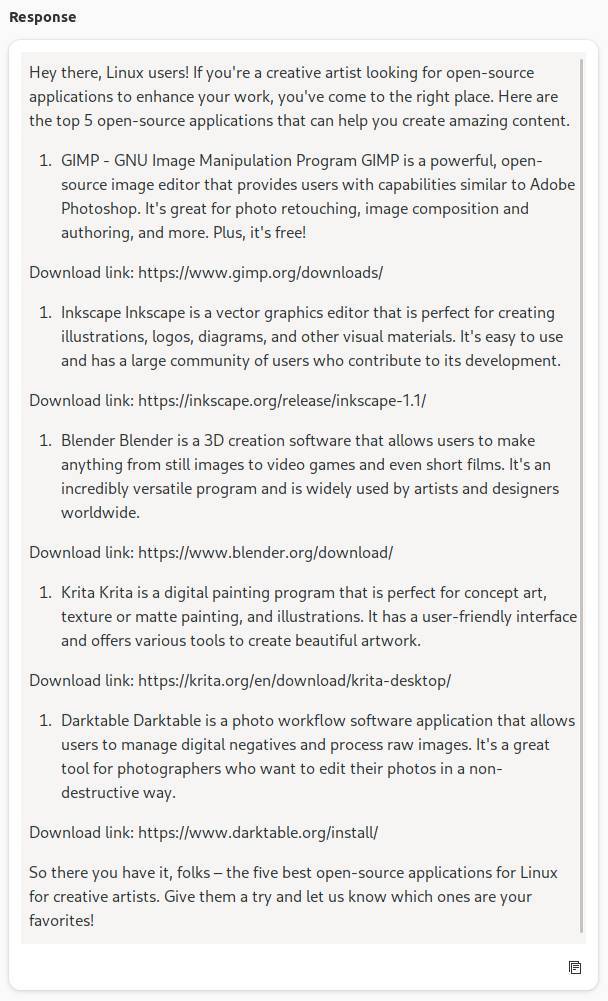
As you can see, you can influence what your answer will look like through additional information in your question.
One last example is the inclusion of references or sources in the results, which is my preferred way of using AI, so I can give credit to the original authors. Just ask to include the used sources in your message.

And here is the result.
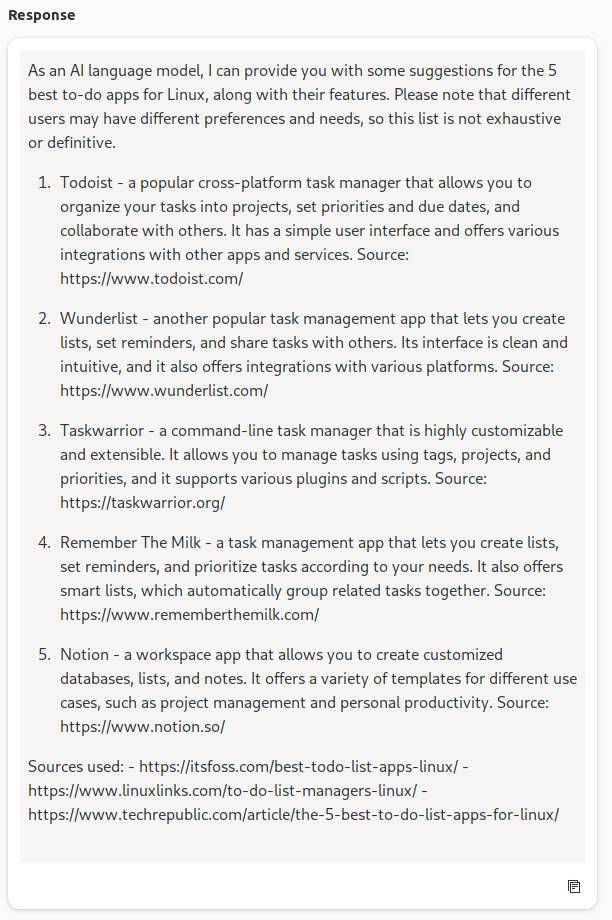
This is a mini-review, so I won’t go further into too much detail. I think I’ve shown that Bavarder is a simple yet powerful AI solution for Linux. Bavarder is of course mainly the front-end, so the graphical shell on top of the available AI models that are also being used in other applications, but the simplicity with which Bavarder brings AI to the Linux user is a powerful choice. Further, keep in mind that Bavarder will not show you graphical results, so you can’t ask it to generate art or come up with maps for example. But it will respond nicely that it is not able to produce visual content. However, it can describe what you asked for.
How to download and install Bavarder
You can simply download and install Bavarder via Flathub. Before doing this make sure that your Linux distro supports the Flatpak package format, by checking the following page:
Here you can find explanations on how to set up Flatpak support for many different Linux distributions.
When you have enabled Flatpak support, do the following:
1) Go to https://flathub.org/en-GB/apps/io.github.Bavarder.Bavarder.
2) Click on Install.
3) Go to your Downloads folder, find the io.github.Bavarder.Bavarder.flatpakref file, and double-click it.

4) Now click on Install to finish the installation process.
Final words
More and more AI models and front-end solutions on top of these models are becoming available. Baverder also uses the available models but does so via a very simple user interface. A Message and Response area is all it has to offer. But if you become more adept at describing your question specifically and the way the answer should look, you don’t need much more.
With a number of follow-up questions with increasing detail, I have provided a first insight into what is possible with Bavarder specifically and with AI models in general. What you may also begin to see based on the answers is the ease with which you can generate a full-fledged blog post or article with a simple question and if you want, you can also publish it directly, submit it as a result of a writing assignment for your training, etc. And here we come again, in my opinion, to the dangers I mentioned earlier and in my article “How AI can help you be more productive“. In my research, I see that it is increasingly observed that blog posts, articles, and even entire books, are generated and published via AI, without actually mentioning that AI was used, and without reference to the underlying sources. I really see the potential of AI myself, and I think this is just the beginning, but that only makes it even more important to be aware of the dangers and the ethical dilemmas as well. But when you use AI to bring you new ideas for further research, help you overcome writers-block, or give you more information to support your new blog posts, and for sharpening your creative results, and you include that in a proper way,I see great possibilities.
Have a look at my latest book on Linux, in Paperback or Kindle format.
For more info on my book click here.
When you want to buy the book click on the image below.

